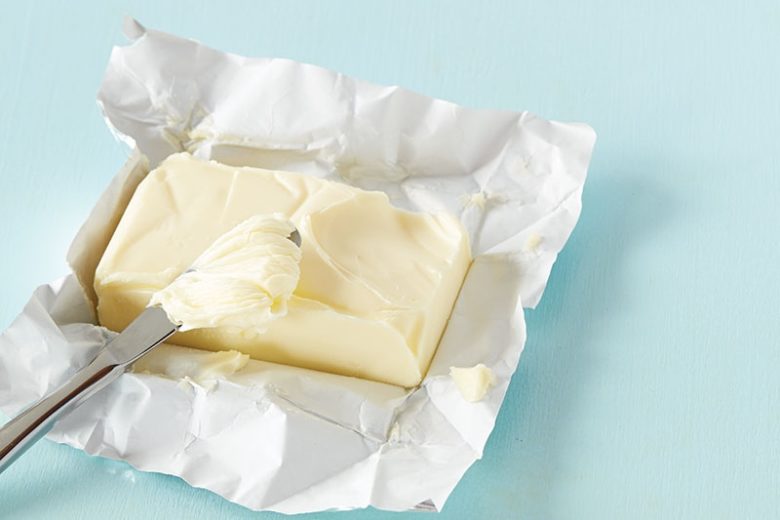
In commercial creameries, butter making follows a similar process: Heavy cream is separated from whole milk by centrifugal force and churned vigorously until the membrane around milkfat breaks down, letting it emulsify naturally into a semisolid. After draining off the liquid (buttermilk), salt may be added for flavor and preserving; salted butter provides somewhat more sodium (often 30 milligrams or less per teaspoon) than unsalted butter.
Butter contributes a small percentage (2.4 percent) of saturated fat in the U.S. diet — and in moderation, most people can enjoy butter as a spread, a flavor enhancer or an ingredient.
One teaspoon of regular butter has about 4 grams of total fat and 2.5 grams of saturated fat, which can fit into a 2,000-calorie daily eating plan with limits of 65 grams of total fat and 20 grams of saturated fat. Light and whipped butters have less fat, saturated fat and calories. Butter blends provide less saturated fat but not less total fat.
Butters in the Dairy Case
While "butter" may be used to describe spreads made from nuts, seeds, fruits or other ingredients, bona fide butter is a dairy product. Most butter produced in the U.S. comes from pasteurized cow milk, cream or both. Elsewhere, goat, sheep, buffalo and yak milks contribute uniquely flavored butters. Differences in butter production also deliver differences in flavor, nutrition and culinary uses.
Regular butter (salted, lightly salted or unsalted) is, by federal regulation, at least 80 percent milkfat, 17 percent water and 2 percent non-fat milk solids. If labeled "sweet butter," regular butter is likely unsalted; lightly salted butter may be labeled "sweet cream butter." Use unsalted butter for any recipe calling for butter (recommended for baking) and lightly salted butter as a spread and for general cooking.
Light butter has 50 percent less milkfat and reduced-fat butter has 25 percent less milkfat, so fewer calories and less total and saturated fat. It may contain water, fat-free milk, gelatin or other fillers. Use it as a spread or topping or in sauces; not advised for baking or frying.
Whipped butter is regular butter that's whipped after churning to incorporate air or nitrogen gas. This increases the volume, lightens the texture and makes it more spreadable when cold. The result: fewer calories per volume measure. Being less dense, it can't substitute for regular butter in cooked or baked recipes. Use it as a spread or topping.
Butter blends combine butter with canola, olive or other oils for a buttery, soft spread. Some blends have added flavorings, such as garlic, herbs, cinnamon or honey. Butter blends provide less saturated fat, not less total fat or calories. Use it as a spread or quick-melting topping; not advised for baking.
"Butter-like" spreads contain little or no real butter and are not recommended as substitutes for butter in cooking or baking recipes.
Clarified butter, or ghee, is butter that's been melted slowly over low heat to separate and remove water and milk solids. Longer melting results in a nutty flavor, longer shelf life and a higher smoke point (375°F to 485°F depending on purity, compared to about 350°F for butter). Use for sautéing and pan-frying.
Cultured or European-style butter usually is made by adding lactic acid to pasteurized cream, producing a tangy flavor. Its higher fat content (82 to 85 percent) gives a richer flavor and makes pastries flakier and cakes more tender. Buy it lightly salted or unsalted in sticks or tubs. Best use: versatile, but especially flavorful in baking.
Organic butter comes from the milk or cream of dairy animals raised without antibiotics or growth hormones, on feed grown with little or no synthetic fertilizers or pesticides. Best use: any recipe calling for butter.
Preserved butter, available in some ethnic specialty stores, is clarified butter, often made from goat or sheep milk. It's usually preserved with salt, flavored with herbs and spices and aged for weeks or even years until it develops a distinctive, pungent flavor. In the Middle East and Northern Africa, it may be called smen, samn or samneh. Use as a flavoring in couscous and Moroccan and Middle Eastern dishes or as a spread on bread.
Raw cream butter from unpasteurized cream has limited availability, more likely from artisanal producers. The Food and Drug Administration advises that raw milk and its products, even from "certified," "organic," or "local" dairies, don't guarantee food safety.
